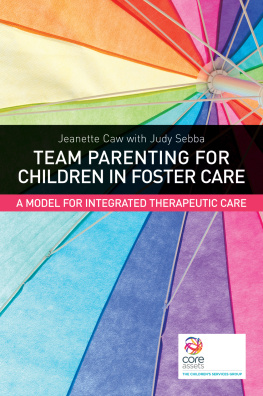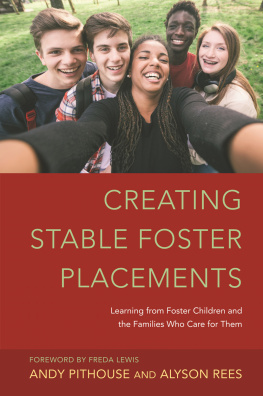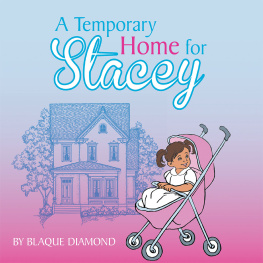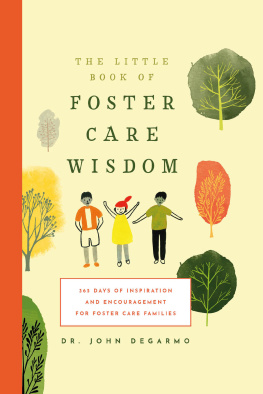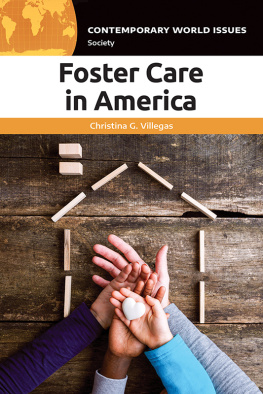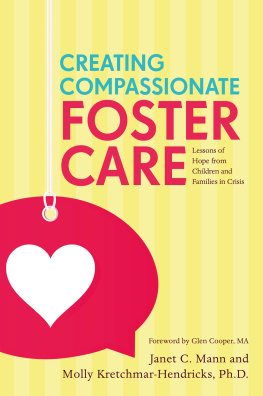Creating Stable Foster Placements
by the same author
The Integrated Childrens System
Enhancing Social Work and Inter-Agency Practice
Hedy Cleaver, Steve Walker, Jane Scott, Daniel Cleaver, Wendy Rose, Harriet Ward and Andy Pithouse
ISBN 978 1 84310 944 0
eISBN 978 1 84642 821 0
of related interest
Team Parenting for Children in Foster Care
A Model for Integrated Therapeutic Care
Jeanette Caw with Judy Sebba
ISBN 978 1 84905 445 4
eISBN 978 0 85700 820 6
Therapeutic Residential Care For Children and Youth
Developing Evidence-Based International Practice
Edited by James K. Whittaker, Jorge F. del Valle and Lisa Holmes
ISBN 978 1 84905 963 3
eISBN 978 0 85700 833 6
Child-Centred Foster Care
A Rights-Based Model for Practice
Annabel Goodyer
ISBN 978 1 84905 174 3
eISBN 978 0 85700 402 4
Understanding and Working with Parents of Children in Long-Term Foster Care
Gillian Schofield and Emma Ward
ISBN 978 1 84905 026 5
eISBN 978 0 85700 489 5
Improving Outcomes for Children and Families
Finding and Using International Evidence
Edited by Anthony N. Maluccio, Cinzia Canali, Tiziano Vecchiato, Anita Lightburn, Jane Aldgate and Wendy Rose
ISBN 978 1 84905 819 3
eISBN 978 0 85700 248 8
Creating Stable Foster Placements
Learning from Foster Children and the Families Who Care For Them
Andy Pithouse and Alyson Rees
Foreword by Freda Lewis
Jessica Kingsley Publishers
London and Philadelphia
Every effort has been made to trace copyright holders to obtain their permission for the use of copyright material. The authors and the publisher apologise for any omissions and would be grateful if notified of any acknowledgements that should be incorporated in future reprints or editions of this book.
First published in 2015
by Jessica Kingsley Publishers
73 Collier Street
London N1 9BE, UK
and
400 Market Street, Suite 400
Philadelphia, PA 19106, USA
www.jkp.com
Copyright Andy Pithouse and Alyson Rees 2015
Foreward Freda Lewis 2015
Front cover image source: Shutterstock.
All rights reserved. No part of this publication may be reproduced in any material form (including photocopying or storing it in any medium by electronic means and whether or not transiently or incidentally to some other use of this publication) without the written permission of the copyright owner except in accordance with the provisions of the Copyright, Designs and Patents Act 1988 or under the terms of a licence issued by the Copyright Licensing Agency Ltd, Saffron House, 610 Kirby Street, London EC1N 8TS. Applications for the copyright owners written permission to reproduce any part of this publication should be addressed to the publisher.
Warning: The doing of an unauthorised act in relation to a copyright work may result in both a civil claim for damages and criminal prosecution.
Library of Congress Cataloging-in-Publication Data
Pithouse, Andy.
Creating stable foster placements : learning from foster children and the families who care from them / Andy Pithouse and Alyson Rees.
pages cm
Includes bibliographical references and index.
ISBN 978-1-84905-481-2 (alk. paper)
1. Foster children--Great Britain. 2. Foster parents--Great Britain. I. Rees, Alyson. II. Title.
HV887.G7P58 2014 362.7330941--dc23
2014015603
British Library Cataloguing in Publication Data
A CIP catalogue record for this book is available from the British Library
ISBN 978 1 84905 481 2
eISBN 978 0 85700 865 7
CONTENTS
Foreword
As someone with many years experience working in foster care, in policy development as the fostering policy manager for the Welsh Government, then as the director of The Fostering Network, it is with much enthusiasm that I write this forward to a book that captures in rich detail the often overlooked home world of foster carers, their children and the children they care for. The research presented in this book and the messages it gives are a timely reminder to all of us, who work to improve outcomes for looked after children, that it is attention to day to day living in a caring family home that can make the biggest difference to helping a child.
Across social care we increasingly encourage practitioners to work with the users of services to build on their strengths and focus on what they can do, not what they cant. Yet all we seem to read from research in the field of looked after children is the poor outcomes of this group. Thankfully, this book is very different, with the research taking a strengths-based perspective to explore the ways children in care and foster families can together create meaningful, stable and mutually enriching home environments.
The Care Inquiry of 2013 published the results of an extensive investigation on how best to provide stable and permanent homes for vulnerable children. The report into the inquirys findings, Making not Breaking, presents evidence from parents, relatives, adopters, special guardians, foster carers, residential workers, academics, policy people and managers and practitioners at all levels. Children and young people provided evidence via focus groups, online surveys and presented their views via film and in person to the inquiry.
The main conclusion was that permanence for children means security, stability, love and a strong sense of identity and belonging. The strong message to the inquiry was that it is the relationships with people who care for and about children that are the golden threads in childrens lives, and that the quality of a childs relationships is the lens through which all in the sector should view what we do and plan to do. It is precisely this hidden domain of the child becoming part of the foster family that the book reveals, in the way it captures those everyday events, activities and attachments that underpin caring relationships that deepen over time.
The research conducted by the authors is focused solely on the home setting and relationships therein and explores the everyday interactions that all families experience. For example, it looks at eating together and the social value of shared mealtimes, often an experience that looked after children have not had with their birth families. Indeed, I remember a foster carer telling me that several adults that she had fostered as children returned for a traditional lunch on Sunday and she regularly had a dozen people attending, continuing the ties made in her family. This book examines how such ties are first made and sustained. It addresses key issues around the childs sense of self and how clothing, bodily care, touch, private space, trusting relationships, tolerance and commitment, all in different ways, and at different times, shape and define the often invisible world of foster care.
From my own professional experience working for The Fostering Network1 in the UK I have long recognised the strong relationships that are made within foster families. The Fostering Network has a history of highlighting the valuable role that men, and sons and daughters of foster families play in foster care. Men can be foster carers alone or as a couple and have a huge role to play in demonstrating positive role models for children who may have had very little contact with men or may have only had negative experiences. The families in this study recognised the value of the males role and where there was no adult male partner often a son in the family would ensure they were involved with the fostered child.


